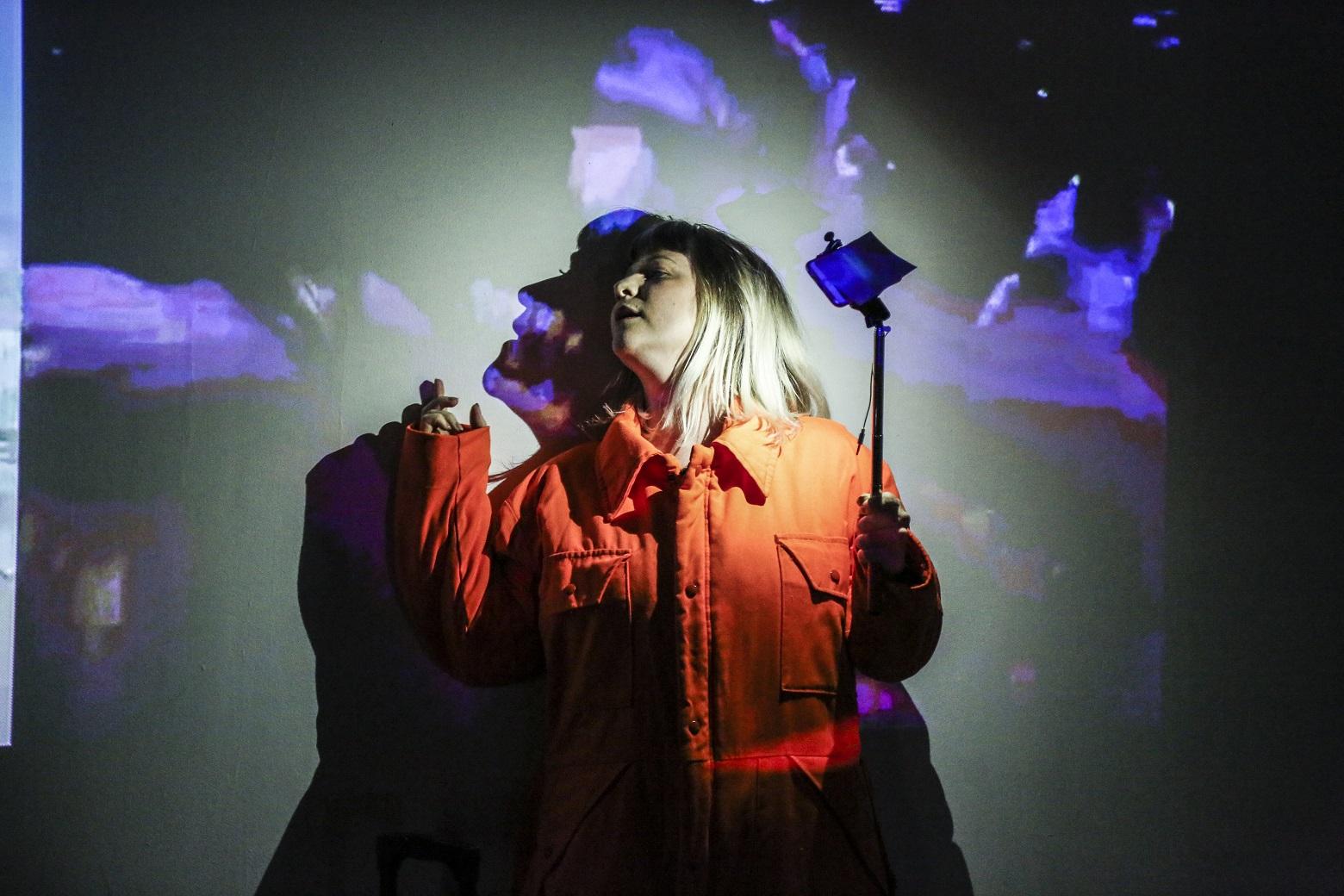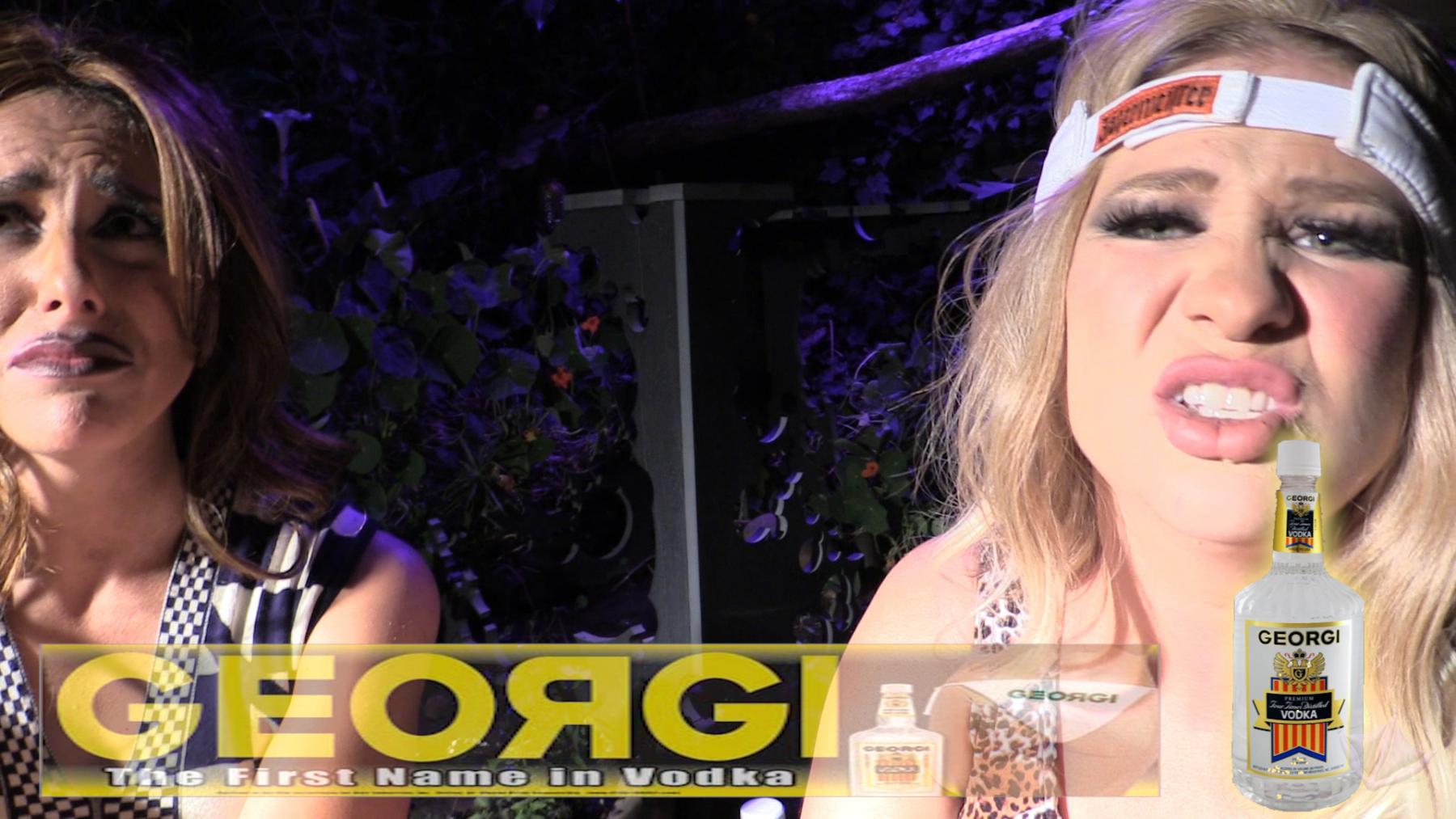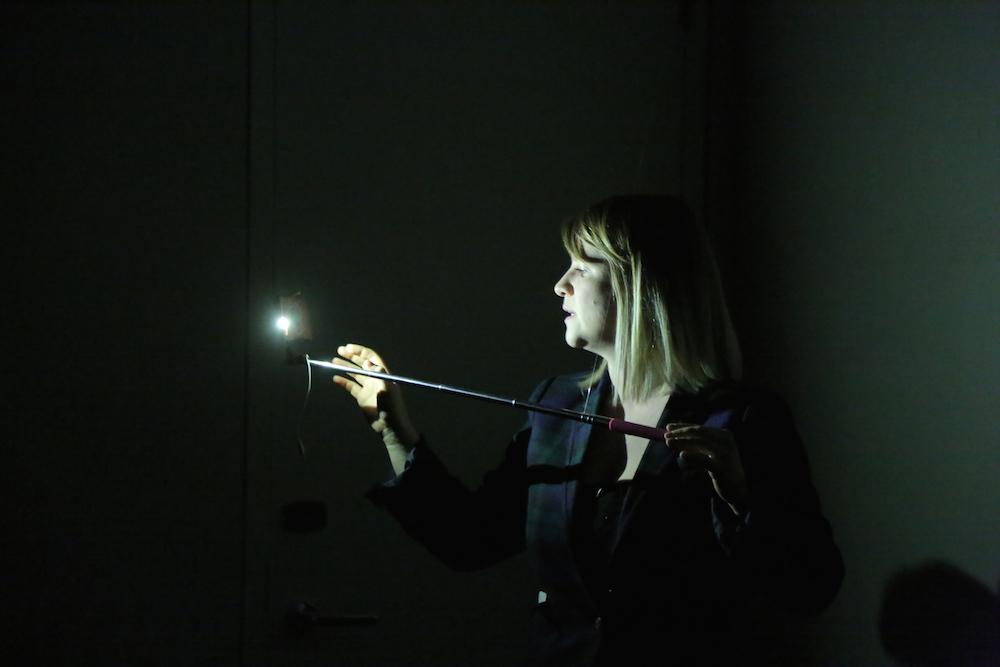
For Máire Witt O'Neill, generating personas is akin to summoning something unconscious within herself. She compares this to performing an exorcism. This process is in many ways an act of critique and scrutiny but it's in no way combative. She mines her own amalgamated overwrought emotional and social exchanges to build characters that are often conflicting, contradictory, and hard to pin down. Given that our everyday interactions are often through intermediaries, be it implicit or otherwise, O'Neill theorizes this as a destabilizer for ideas of "truth". In turn, it allows for a slippage of the good and the bad and as she describes in our conversation, "a "groundlessness". O'Neill uses this space of instability as a means to trouble authority inherent within reality. She does this independently and collaboratively by using the visual language of reality television both as a sort of red herring and a point of direct confrontation. When we spoke with the Chicago based-artist, she insightfully articulated the nuances behind her developing multidirectional practice, which over the last ten years, has partly been in tandem with her creative partner Mia Ardito. They work as the duo Mia+Máire on productions like Soft Pants Studios, Sad Girls Club TV and the now Maggots Club TV.
In our chat with O'Neill, she candidly recounted her discovery of performance as a medium, her immersive installation work which extends from her color-besotted videos, we also discussed how language and writing functions in her work, and her early Barbra Streisand impersonations among other talking points.
while everything is mediated, this makes it no less “real” (in a functional way). I believe that truth is unknowable and that reality is provisional. Our experience is dependent on mediators and those mediators are very real, but their “truth” or “facticity” is unknowable. This leaves quite a bit of room for good and for bad, but I think accepting the groundlessness and uncertainty is a starting point toward understanding and communicating better with others.
How did art come to you, and you to it?
I grew up performing and come from a family of performers. I didn’t know I had a food allergy and wouldn’t find out until I was 24. I started skipping the choir to go to the painting studio because my voice was so tired and I could paint silently. I was told I had “silent reflux” and stomach acid on my vocal chords had caused nodes. I spent my senior year going to doctors and speech therapists, on steroids and vocal rest, but also trying to pretend none of that was happening for fear that my roles and performing opportunities would be taken away. Being a generally hyper and loud human, I had to hide away instead of socializing. So I kept making art. I was becoming deeply passionate about visual art, feeling like I’d found a community that I wanted to really be a part of and a discipline that felt like it had more space for me to think. I ended up applying to art school and loving it. In my sophomore year of art school, I had a conversation about fear with an old friend and teacher. I thought at first that I wouldn’t be scared to make anything, but then that couldn’t actually be true. So I realized that singing in front of my new community of visual artists, who had no idea about this other side of me, would be the scariest thing I could do. This is how I started making work that was more obviously performance art.
Why performance as opposed to other means of working and mediating ideas? How did you arrive at this way of working?
Before I made my first Barbra Streisand impersonation piece, I was basically making relational aesthetics work without knowing it. I was making spaces and experiences for people. I think what I make comes from a brain that thinks a lot about motivation, much like an actor does. Even now, when I’m making sculptures, performances, or videos I tend to find myself thinking something like “what does the gesture of making this do?” or “what would the experience of viewing this prompt?” For me, performance is a way of thinking or a point of origin to go back to when thinking about a piece. When I am performing live or for the camera, whether solo or with collaborators, it tends to be a bit like performing an exorcism. We talk about this a lot when making SGCtv (or now MGCtv/Maggots Club TV) that we are summoning something and exorcising it.

Flip from Sad Girl Club TV
You have played characters like Flip, Kathryn Teller-Jones, and Lydia Stein or even the character you take on in your lectures, all of whom are not necessarily archetypes per se. However, they all seem fairly familiar because we've seen them in some sort of widespread media. But here they are larger than life, what do you think you want to show us when you step in these roles?
I am usually pulling something out of myself (often something that worries me), but they are also characters that have been embedded in me from years of media consumption and observing people in day to day life. I think that people are conglomerations of curated influences (even when our curatorial decisions are not intentional). We notice things and imitate them. Imitation is how we learn to do most things in life: walk, dress, etc. And I don’t see this as a negative thing or anything to be afraid of. I think that while our work comes from us, we come from the world and it is all a cycle of response. So sometimes a part of me notices itself in someone else, whether I like it or not, and that has compelled me to pull that part out and stick other things onto it—creating a persona that I can both relate to but also see as a sort of allegorical figure—in order to look more closely. It is an act of critique, but one where I try to come from a point of humility and exploration. I see critique as a gesture of respect, and I try my best to do it respectfully so that it can be seen as such.

Documentation still from Look Good For You, 2015
So in a lot of ways these roles are self-reflexive.
Very. Flip came out of an interest in looking at the part of me that (mostly in high school) just wanted to be “ one of the guys” and who didn’t understand the importance and relevance of feminism yet. Of course, I was never actually Flip, but there is a side of me that wants to be powerful and popular and Flip was an experiment in drawing that out to a potential extreme. Flip is also someone who is constantly talking about being “chill,” but her actions are typically not so chill. This paradox is something that resonates with me—projecting something into the world while also performing its opposite. I don’t think that means she is “fake” or “lying.” It is more complicated than that. One thing to glean is that Flip wants to be chill. I think that is important information and is quite enlightening. This is a small example of the kind of reshuffling of judgement and interpretation that I value. Looking more closely at how we can live within contradictions is especially reflexive for me.
Television is a language you and Mia have been broadly working through with Soft Pants Studios, Sad/Mad Girls Clubs, and Big Bratz. It's a medium that has long been a major mediator for how public perceptions are formed based on what it presents. How do you guys think about your use of the medium as a space for performance?
Mediation is our bread and butter. It’s our mode and route and way. And it is all we really have to go on. While everything is mediated, this makes it no less “real” (in a functional way). I believe that truth is unknowable and that reality is provisional. Our experience is dependent on mediators and those mediators are very real, but their “truth” or “facticity” is unknowable. This leaves quite a bit of room for good and for bad, but I think accepting the groundlessness and uncertainty is a starting point toward understanding and communicating better with others. The forms of mass-media are useful and interesting to me because they function as diversions—like saying “hey look over there!” and then grabbing a french fry. Not that I’m trying to steal from my viewers! I tend to like using an example typically seen pejoratively as a positive. I am constantly asking to be tricked in order to short-circuit my bad habits—like being late. At the same time, I don’t like feeling duped and don’t want to do that to my viewers. So the goal has been to balance the trickster with the giver. Television is a giver, it gives what the viewers want. So it’s like the spoon full of sugar. But additionally, it is often seen as fake or superficial, and I don’t exactly believe in those ideas as they’re used colloquially. So in order to scramble up the authority of reality and certainty, I like using a medium that seems to be given very little authority consciously (reality tv) but quite a bit of power—then I can hack at it and scramble it and make it point toward groundlessness.

Mia + Máire in Women on Women production as part of Soft Pants Studios
How do you see the sculptural sets and installations functioning in conjunction with your video installations? Take, for example, the Dorito infused setting you had for your MFA show.
The installations point toward the act of watching as content, not just what is on the screens. It extends the space of the work to include the space of the viewer and their performance of viewing. I think that this goes back to what I said about why I make performance: the installations are a way for me to point out the other performances that are happening. The installations tend to be a lot like the video work, in that they are simultaneously many things: comfortable, typical, repulsive, annoying, confusing and almost the thing that they are.


Top Image: Mia + Máire, Sad Girls Club TV Presents The SGCtv Big Bratz Showroom and Room for the Show Site-specific installation view, Goldfinch Gallery, Chicago, IL Bottom Image: Reality is Provisional (Provisional Title) featuring Sad Girls Club TV s4 e1-6, Sullivan Galleries, Chicago, IL
Dramatics and hyperbolics-, chaos, grudges, and feuds continue to be mainstays for reality tv. Do you think that drama plays a role in the power you mentioned reality tv has? What do you think dramatics and character/situational hyperbolics(which is very evident in SGTV), elicits from audiences?
Yeah sure, I think drama has always played a role in the entertainment and art that people have gravitated towards. Drama pulls us away from the mundane, but on reality tv, we are looking at the mundane as well. Somehow it’s dramatic to see two people sitting around talking when it’s on reality tv. I think that filming and editing these moments is in and of itself the creation of hyperbole. Perhaps reality tv is hyperbole in its entirety: an exaggerated document of day to day life that should be taken literally as what it is: television. Television is a vision from a distance, whether that is physical distance, temporal distance or a distance of mediation. Maybe it is the distance that provides the drama. The distance allows moments, people and spaces to be othered, and that otherness is dramatic. But the banality of the scene combined with that othering makes it this recipe oddly perfect for American audiences; a seemingly American desire to look and other the object of our gaze combined with easy and comfortable banal happenings, all with a bit of vicarious pleasure globbed on top.
There are these overt logos and product placements that pop in and out of SGCTV episodes, and even some of your websites have these logos that adorn in the footnotes,-such as Apple, Dunkin Donuts as well as various fictional products. How are they being employed in the context of these performances?
This is definitely another example of the layering reality tv hyperbole. Unauthorized branded content is everywhere, and nonstop in our work. Brands have become language and content, so when we reference a brand it stands in for a whole world: a succinct kind of language in our capitalist society.
In addition to the unauthorized branded content, we also wanted to make commercial breaks “moments of rest” in Season 4 of SGCtv. So the actual “breaks” provide breathing room from the show which can move so quickly and have so many layers that it can be exhausting. Then the commercial breaks come on and they feel like they’re giving you a moment to breathe. But it’s still advertising, but it’s not made by or authorized by the brands/companies it advertises for. So is it the same thing? This is similar to the question of what happens when our characters do or say something, but it’s our body and it is a character we created and perform.
There are certainly undesired endorsements in our society. When it happens politically, it is often expected that the subject disown the endorsements that they don’t want to be identified with. When they are silent or unclear about it, that message leaves a lot of room for interpretation, which may be quite intentional. This also happens in a Yankee Candle Haul or unboxing video, but Yankee Candle isn’t mad at it—it’s a labor bartering system. This is all to say that I think our unauthorized endorsements in SGCtv of basically every brand or product that we can think of is a sort of dare to this mass of capitalist power to disown us, it's inevitable customers and laborers. But of course, they would never, they want and need us. So, SGCtv is a combined performance of production and consumption all in one marketable package ready for its own unboxing video but there’s never any box to unbox because all we make are boxes. That’s one way of looking at it.

Still from SGCtv s4e3 -- Georgi Sit-down with Tati and Flip
It seems like writing/use of specific language becomes a significant component in your performances as speech becomes a way to convey your characters. Since you sometimes work collaboratively, how do you see writing and language-making as part of your performances?
I had a rough relationship with writing when I was young, but then had a good teacher (and the chutzpah to say something when I was in complete disbelief that my paper could receive a D—[laughs]) who helped me realize that writing is flexible and should be manipulated. I think a lot of people understand this early but it took me longer to learn that editing was not undoing, but rather a part of the process. I love writing now which I think relates to my love of editing in video too. One thing that I’m trying to navigate now in my writing is that while I have been trained to write with decisiveness and conviction, I am interested in writing about uncertainty; the form I’ve been trained in doesn’t actually work for that kind of content. I think that this paradox is also related to my tendency to reverse the reception of words, such as using a word that is typically invoked in a pejorative way in a positive sense. Language is a mediator too. We assign labels that are useful in some cases and less in others. So the malleability of language is still fascinating to me. I like to experiment with using language that I think has a primary or typical meaning, and then undermine that usage and meaning later. My solo work is currently very language-based, I do a lot of writing for it, and the back and forth between certainty and uncertainty is a huge focus —it (in its totality) is the form and the content, instead of one or the other.
We do similar things in SGCtv—we’re playing a lot. Language is thrown around, mixed, matched and mingled, chopped screwed and twisted. Spitting things out and responding to each other, feeding lines and re-doing lines with replaced words over and over again. Our shoots are nonstop experimentation sessions, where I’d say at least half of the time is spent playing with language.

Documentation from What Am I on To?
Lastly, in thinking about mediation, do you think the corporeality of performances (especially live ones)can transmit unmediated content between performer and audience?
No [laughs]. I don’t think that we are capable of transmitting or receiving unmediated content. I see mediation as what happens when information passes through whatever media it is transmitted and received through. So even air, light, eyes, ears, brains with subjective positionalities, time, space, etc.—these are all mediators. We could see them as having a minimal effect on the information or we could see the “information” as reliant upon and changed by these mediators. I don’t think of mediation as something we should try to minimize, I think it’s something we should recognize, utilize, accept, investigate. The “reality” or “authenticity” of mediation is something I am interested in.